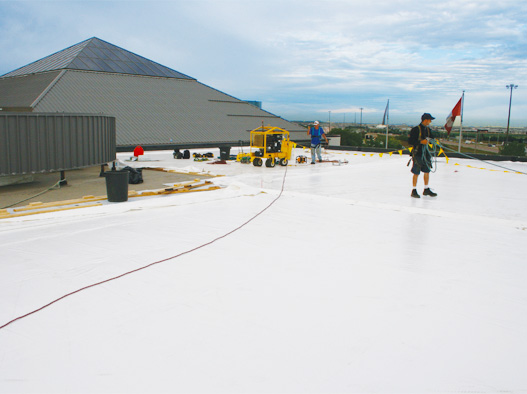ROOF CONDITIONS FACTOR
INTO SOLAR PV PAYBACK.
Many solar energy advocates are promoting the benefits of rooftop installations, but building owners should also be aware of the risks. Solar photovoltaic (PV) panels transform a roof into a worksite that must support both the equipment and a retinue of personnel who operate and maintain it. If the roof is not in a condition to support this, building owners can end up losing a lot of money.
Solar PV systems are likely to perform as promised since the systems are highly engineered and are well-proven worldwide, but other considerations should be factored into any decision to install the equipment or lease out roof space to third parties. Prospective participants in programs like Ontario's feed-in tariff (FIT) shouldn't simply focus on the returns from a 20-year contract to sell electricity without considering other possible long-term repercussions.
Some disconcerting examples can already be found. One unsuspecting building owner signed a contract to lease rooftop space for a 5% share of the annual proceeds. That also included an agreement to take responsibility for the condition of the roof and to replace the roof if necessary during the lifetime of the 20-year contract.
 White roofs with greater reflectivity can reduce summer cooling costs due to the added insulation between the existing roof and the membrane.
White roofs with greater reflectivity can reduce summer cooling costs due to the added insulation between the existing roof and the membrane.
Roofing experts estimate the existing roof could last seven to nine years under normal conditions, but added traffic from housing the solar PV system is likely to speed up that timetable. As a result, the building owner faces the prospects of an earlier and costlier roof replacement - requiring an investment of approximately $600,000 for a high quality roof capable of supporting the solar PV systems configuration, weight and associated traffic - for a promised return of $350,000 over 20 years.
Marketers are promising paybacks of seven to nine years on solar PV installations, but adding the cost of a new roof into the package will obviously change that schedule for a return on investment. Promises of an even speedier payback should be viewed skeptically, and owners are advised to take bids from more than one vendor before making a decision.
In leasing out rooftop space, building owners should think about and contractually stipulate which party holds responsibility for issues such as added stress on the roof system, possible additional costs and/or risks of performing maintenance in close proximity to electrical equipment, and liability if roofing work causes damage to the solar installation.
Building owners should be sure to address any proposed modifications and deviations from the manufacturer's standards prior to the installation to avoid nullifying warranties. They should also be aware that roof warranties typically exclude third party damage.
Consider, too, the potential cost and logistics of decommissioning systems after the FIT contract has expired. Will the system be taken down with the same care with which it was installed? What happens to the roof should damage occur? How much pedestrian traffic can a roof that has supported a PV solar system for 20 years handle?
Ideally, building owners should write the contract so that they would receive an upfront payment to replace the roof prior to the installation of the solar equipment. Roofs that are specifically designed to accommodate solar installations can also have other economic and environmental advantages. For example, white roofs with greater reflectivity can reduce summer cooling costs due to the added layer of insulation between the existing roof and the white roof membrane.
If an existing roof is less than five years old and properly installed with good craftsmanship, upfront replacement may not be necessary, but owners should still be proactive in protecting themselves. They should always obtain an inspection and roof assessment report before and after the PV system has been installed.
This article originally appeared in the November 2010 issue of Canadian Property Management, Vol. 25, No. 7



